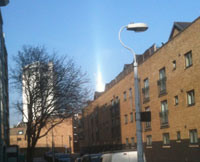What is the next big growth location in London?
Irvine Sellar: The Shard. It’s more than a building, it’s a vertical town, with restaurants, retail, 600,000 sq ft of offices, the hotel, 10 very special apartments and the viewing galleries. We also have its sister building, the Place, a new rail station concourse, new bus station and public plaza linking all these together. Compelling, clearly.
Gavin Poole: We also have a unique building in a growth area: east London. iCity appeals to the creative, tech and broadcast sectors, but it’s not a replacement for Shoreditch, it’s a philosophy around the Tech City initiative. Corporates are realising that what we are about to deliver is going to be unique and they are looking at being part of the innovation campus we are creating.
Simon Allford: King’s Cross is an amazing place and it’s on the edge of the heart of London. What is interesting with all these projects is that they are all where there was phoney infrastructure, and that gives us opportunity. Where there are big problems to unlock you create big sites. It’s interesting that Stratford, a big railway site, King’s Cross, and London Bridge have a kind of problem connection. They have a cultural mix and people looking to make them work, so I think the infrastructure site is the one that’s going to win out.
Is transport infrastructure the king-maker for place-making in London?
Ian Lindsay: Crossrail will benefit property values in a number of areas: Canary Wharf is set to be a major beneficiary, but so too Farringdon, the Tottenham Court Road station area and also places in the west like Southall and Ealing Broadway and out east to Whitechapel, Custom House, Woolwich and Abbey Wood.
Over the past 25 years we have been reasonably fortunate to see the DLR, the Jubilee Line extension, Tube upgrade, London overground and now Crossrail. But the challenge we face is that in that time London’s population has grown by almost 1m, and we are looking at growth of almost 1m more over the next 10 years. We can’t afford to rest on our laurels.
How important is the private rental sector in supplying new homes to Londoners?
Mark Ridley: Absolutely fundamental. The need for greater scope in the private rental sector in terms of consumers is really important, and seeing institutional investors coming in to provide that is really important. It is also vital for London to have the international buyers it has because they let the units back out into the private rental sector.
Is the pricing growth of London residential sustainable?
Richard Dakin: Prime is up 50% in the past four years and that isn’t sustainable. If you look at the fundamentals, everything will tell you that they appear very expensive. But the demand and supply stats show that over the past 10 years London’s population has gone up by 800,000 and only 200,000 new homes have been built. Add to that the fact that London is currently seen as a safe haven, and you see that the demand and supply imbalance is likely to continue for a few years. I don’t think price rises will continue at the rate we have seen, but prices appear fairly sustainable at the current level.
How important is expanding airport capacity?
SA: London is a tiny little dot on a tiny little island and as much of a fan as I am, it’s absolutely crucial that we are connected. Whether an airport goes east or west, it may be that the issue is more to do with attitude to planes and the politics of planning than actually saying it must go one way or the other, and putting all your eggs in one basket seems to me wrong. London offers it all: if you don’t like Paddington, you can go to White City. If you don’t like White City, you can go to Canary. If you don’t like Canary, you can go to King’s Cross. But the point is that choice is the thing.
Is HS2 a cost or benefit for London?
Andy Bruce: There is a political dimension to HS2. London is tearing itself apart in some people’s minds from the regions. There is a significant wealth gap which has a political dimension and that’s the story behind HS2. It’s not so much “Do we need the rail link?” it’s “Birmingham wants to see some investment”. It doesn’t want it all centred in London and if it’s not HS2, where is London going to share some of the value it has with the rest of the UK?
One year on from the Olympics, what is the real lasting legacy?
GP: The lasting legacy will be a fantastic economic centre for growth in east London that will create 4,500 jobs. All we used to hear about the area was poverty and deprivation, but what you are going to see now is growth, regeneration, investment, fantastic universities, brilliant properties, new schools, new medical centres, new community centres and it goes on and on. The Games was just one summer that took seven years to build but the legacy is a 20-year plan that will impact many generations to come.











